After
the Mewar school, the grandeur of the Marwar school of painting is well
expressed in the Jodhpur style, the Bikaner style and the world-famed
Kishangarh style as well as in the substyles of Jaisalmer, Naugore, Ghanerao,
Sirohi, Ajmer. The Kishangarh style has a unique character, but being in a
state of Rathores painting there should be linked with the traditions of
Jodhpur.
 Like
Mewar, Maru Pradesh followed the traditions of Ajanta. Its preliminary form may
be seen from the artistic shape of the gate of Mandore.' This region attained
fame in the domain of art and culture under the rule of the Gurjara-Pratiharas.
Like
Mewar, Maru Pradesh followed the traditions of Ajanta. Its preliminary form may
be seen from the artistic shape of the gate of Mandore.' This region attained
fame in the domain of art and culture under the rule of the Gurjara-Pratiharas.
Tara
Nath, a Tibetan pilgrim, referred to Sridhar as an artist of the 7th
century in Maru Pradesh. This confirms that the Marwar school of painting had
its own earlier traditions. In ancient times, this territory was a part of
Gujarat state, and that is why the paintings of western Rajasthan cannot be
dissociated from the developed form of the Gujarat, Jain, Apbhransh and other
styles. It is assumed that many pictorial Jain and Apbhransh texts were
executed in Marti Pradesh. In reality, Rajasthan painting emerged from the Jain
and Apbhransh styles. Western Rajasthan remained the centre of these styles.
Rashtrakoot
Rajputs established their rule in ancient Maru Pradesh. The art of painting
developed in Jodhpur under Jodha of the Rathore dynasty, in Bikaner under
Bikaji, in Kishangarh under Kishan Singhji. In the neighbouring states it was
known as the Marwari school of painting, which flourished in many styles and
substyles.
Jodhpur Style
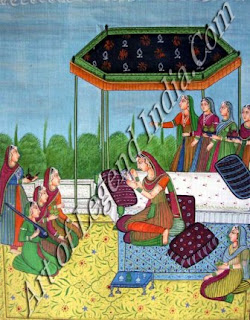 After
establishing his kingdom, Jodhaji contributed impressively to the prosperity
and enrichment of Indian culture in this new field. The Jain, Gujarat and
Apbhransh styles were revived in new form. Credit goes to Maldeo (1532-68) for
giving renewed vigour to the cultural traditions and artistic perspectives of
Marwar. Before him, the Marwar style maintained its complete mastery over the
Jodhpur style, but MaIdeo carved out an independent Marwar and devoted himself
to the growth of the arts. From the point of view of primitive art, the
Uttaradhyayan Sutra of his time, now preserved in Baroda Museum, occupies a
prominent place. Glimpses of paintings of that age may also be visualised in
the frescoes of Chaukhela Palace.
After
establishing his kingdom, Jodhaji contributed impressively to the prosperity
and enrichment of Indian culture in this new field. The Jain, Gujarat and
Apbhransh styles were revived in new form. Credit goes to Maldeo (1532-68) for
giving renewed vigour to the cultural traditions and artistic perspectives of
Marwar. Before him, the Marwar style maintained its complete mastery over the
Jodhpur style, but MaIdeo carved out an independent Marwar and devoted himself
to the growth of the arts. From the point of view of primitive art, the
Uttaradhyayan Sutra of his time, now preserved in Baroda Museum, occupies a
prominent place. Glimpses of paintings of that age may also be visualised in
the frescoes of Chaukhela Palace.
Many
paintings of the early 17th century belong to the Jodhpur style, and even
though highly influenced by the Mewari style possess their original character.
Many paintings of the time of Raja Shur Singh (1595-1620) are preserved in the
art and picture gallery of Baroda and in the private collection of Sangram
Singh. Shur Singh was an art lover. Dhola-Marit is among the artistic
historical pictorial texts compiled during his period and the Bhagwad of Pustak
Prakash, Jodhpur, painted in 1610, is endowed with many special local features.
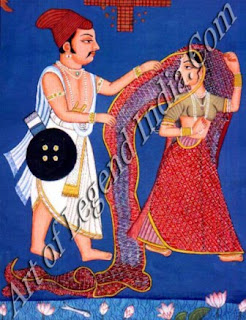 Rag-Main,
an illustrated text painted in 1623 and preserved in the private collection of
Sangram Singh, is a compilation of great historical value painted for the
famous Vitthal Dass of Pali. These paintings are considerably influenced by the
art of Marwar.
Rag-Main,
an illustrated text painted in 1623 and preserved in the private collection of
Sangram Singh, is a compilation of great historical value painted for the
famous Vitthal Dass of Pali. These paintings are considerably influenced by the
art of Marwar.
Some
miniatures based on verses of Sursagar in the middle of the 17th century
in the Jodhpur style are preserved in Baroda Museum and in the collection of
Sangram Singh. They express poetic sentiments elegantly. Rasikpriya, also
available in Baroda Museum, was painted in the same period. Its sharpness of
colour combination and abundance of ornament deserve special mention.
Another
phase of Jodhpur art started in the reign of Maharaja Jaswant Singh, a man of
high intellectual qualities and a keen lover of art. In his reign, Marwar
became an important centre of the Krishna-Bhakti cult, which became the subject
of many paintings. Jaswant Singh was the commander-in-chief of Aurangzeb hence
the impact of Mughal art was inevitable.
The
impact of the Mughal school in its original form has been noted in the Jodhpur
style paintings of this period. They are very simple, and the sharp outlines,
the expression of sentiments and colour combination in these paintings are
notable. Because of the spread of the Krishna-Bhakti cult, the effect of folk
art on the Jodhpur school calls for study. Traditions of folk painting were a
common feature of the Jodhpur style.
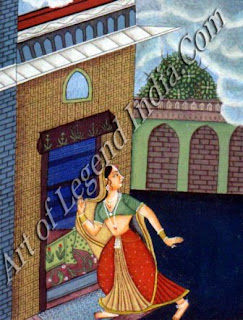 Because
of the great valour and courage of Durga Dass, the reign of Ajit Singh was a
landmark in the annals of the development of Rajasthani art. Paintings of that
age had themes like Rasikpriya, Geet-Govind, poetical texts and aspects of the
royal court, hunting, festivals, processions, pictures of kings and feudal
lords. Royal patronage in the reigns of Abhaya Singh and Rain Singh to artists
in the Jodhpur style was generous. In the 19th century, the Nath
sect dominated the life of Marwar.
Because
of the great valour and courage of Durga Dass, the reign of Ajit Singh was a
landmark in the annals of the development of Rajasthani art. Paintings of that
age had themes like Rasikpriya, Geet-Govind, poetical texts and aspects of the
royal court, hunting, festivals, processions, pictures of kings and feudal
lords. Royal patronage in the reigns of Abhaya Singh and Rain Singh to artists
in the Jodhpur style was generous. In the 19th century, the Nath
sect dominated the life of Marwar.
In
1803, the last phase of the Jodhpur style opened in the reign of Maharaja Man
Singh. Avasji Deo Nath was the spiritual guide of Man Singh," and painting
flourished in many monasteries. Sixty-three paintings of this period based on
the Ras-Raj of Mati Ram were recovered from a monastery belonging to the Nath
sect and are preserved in the private collections of Ram Copal Vijayavargia and
Sangram Singh and in the State Museum, Jaipur.
Though
in this period many paintings in the Jodhpur style were produced they were not
of high artistic quality. In towns like Kuchman, Naugore, Pali, Jalore, feudal
lords also encouraged painting after building galleries.
In the
middle of the 19th century, with the-advent of photography, the Jodhpur style,
like other styles of painting, started deteriorating.
Salient Features
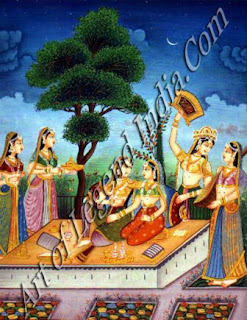 The
Jodhpur style is the principal style of the Marwar school, but even today a
large number of paintings in this style are not available, and whatever is
available belongs to the early part of the 19th century. Despite
being influenced by the Mewar school, the Jodhpur style has its own striking
features, and as a result its separate constitution comes to light.
The
Jodhpur style is the principal style of the Marwar school, but even today a
large number of paintings in this style are not available, and whatever is
available belongs to the early part of the 19th century. Despite
being influenced by the Mewar school, the Jodhpur style has its own striking
features, and as a result its separate constitution comes to light.
Males
in this style are stoutly built and tall. Their curved mustaches, touching
their throats, raised turbans and dress decorated with royal splendour are very
impressive. The limbs of females are shapely and plump.
Besides
local influences, the impact of the Mughal style also deserves special
consideration. Application of folk art, combinations of red and yellow,
depiction of feudal splendourand of simple life are also highlights of this
style. Where drawings of palaces and palatial buildings were made extensively,
in respect of scenery, paintings were created to suit the tastes of the
capitalists of Marwar.
Principal
artists of this style whose names have been identified include Virji (1623),
Narayan Dass (1700), Bhatti Amar Dass (1750), Chhajju Bhatti, Kishen Dass
(1800), Danna (1810), Bhatti Shiv Dass, Dev Dass, Jit Mal (1825), Kalu Ram
(1831). The Jodhpur style is the principal style of the Marwar school and
requires a great deal of research work.
Bikaner Style
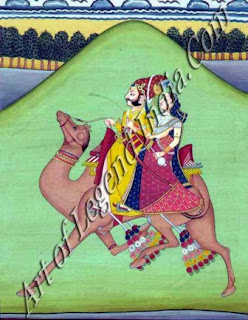 In
distant Maru Pradesh, the state of Bikaner was founded by Rao Bikaji of the
Rathore dynasty in 1488. Being an integral part of Marwar and belonging to the
same dynasty of Jodhpur, the artistic heritage of Bikaner is recognised as a
signifi-cant link in the traditions of the Marwar school. Although influenced
by many external forces, Bikaner maintains its original form intact. According
to the artistic and other styles of Rajasthan, painting in Bikaner commenced
its development from the end of the 16th century.
In
distant Maru Pradesh, the state of Bikaner was founded by Rao Bikaji of the
Rathore dynasty in 1488. Being an integral part of Marwar and belonging to the
same dynasty of Jodhpur, the artistic heritage of Bikaner is recognised as a
signifi-cant link in the traditions of the Marwar school. Although influenced
by many external forces, Bikaner maintains its original form intact. According
to the artistic and other styles of Rajasthan, painting in Bikaner commenced
its development from the end of the 16th century.
Early
paintings in the Bikaner style may be traced to the pictorial Bhagwad Puran
painted in the time of Rai Singh (1571-1591).8 He himself compiled the Rai
Singh Mahotsav and Jyotish Ratnak texts. The impact of the Jain school is
easily discern-ible in the early paintings of Bikaner. Matheran was a Jain monk
who started painting Jain religious texts and exhibited the impact of the Jain
school in the original Bikaner style.
The
Mughal paintings of this region distinctly depict this mutual influence.
Maharana Rai Singh had married Jasmade, daughter of Maharana Udai Singh
(1537-1572). His second marriage took place in Jaisalmer in 1592, hence Bhagwad
Puran (1599 approx.) in Bikaner style, Madhavanal Kamkalanda (1603) compiled
and painted for Kunhar Raj of Jaisalmer, and Chor Panchashika (1540) compiled
by Bilhan in the Mewar style and Rag-Mala (1605) painted by Nasir Di exhibit
great similarity from the angles of techniques and selection of colours.
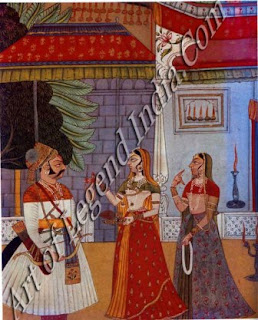 Kalyan
Mal, Raja of Bikaner, established relations with the Mughals after marrying his
daughter to Emperor Akbar. The rulers of Bikaner occupied prominent positions
in Mughal courts." Maharana Rai Singh, who held the exalted position of
governor of Burhanpur in the south from 1604 to 1611, made a good collection of
artifacts. In this regard the illustrated texts of Rag-Mala are very
significant.
Kalyan
Mal, Raja of Bikaner, established relations with the Mughals after marrying his
daughter to Emperor Akbar. The rulers of Bikaner occupied prominent positions
in Mughal courts." Maharana Rai Singh, who held the exalted position of
governor of Burhanpur in the south from 1604 to 1611, made a good collection of
artifacts. In this regard the illustrated texts of Rag-Mala are very
significant.
Hence
the emergence of the Bikaner style appears to date back to the later part of
the 16th century. The seccind phase of the Bikaner style began in the period of
Anup Singh (1669-1698), but the middle link of this style was no less
significant. Because of the non-availability of paintings nothing definite can
be said about this period. In the reigns of Jehangir and Shah jahan very
cordial relations were maintained with the Bikaner royal house.
Because
of this fact mutual exchanges of art and artists frequently took place. The
oldest specimen of the Bikaner style is a painting by Noor Mohammad, son of
Saha Mohammad, in 1606. A large number of such paintings are preserved in
museums and private collections, and a systematic study of paintings of that
age could be undertaken with their help.
 In the
reign of Shahjahan the number of artists greatly increased and many migrated to
other places to receive royal patronage. Because of the indifferent attitude of
Emperor Aurangzeb to artistic activities, artists sought patronage in the
princely states of Rajasthan. The renowned Usta family of Bikaner, which was
concentrated in Lahore in the Mughal period, joined the courts of Maharajas
Karni Singh and Anup Singh at Bikaner in the reign of Aurangzeb. In paintings
in the Bikaner style, the name of the artist along with that of his father and
sanvant are engraved. Usta Asir Khan came to Bikaner from Delhi in the time of
Karni Singh (1650) and developed a high sense of artistry.
In the
reign of Shahjahan the number of artists greatly increased and many migrated to
other places to receive royal patronage. Because of the indifferent attitude of
Emperor Aurangzeb to artistic activities, artists sought patronage in the
princely states of Rajasthan. The renowned Usta family of Bikaner, which was
concentrated in Lahore in the Mughal period, joined the courts of Maharajas
Karni Singh and Anup Singh at Bikaner in the reign of Aurangzeb. In paintings
in the Bikaner style, the name of the artist along with that of his father and
sanvant are engraved. Usta Asir Khan came to Bikaner from Delhi in the time of
Karni Singh (1650) and developed a high sense of artistry.
Maharaja
Anup Singh was a man of great literary taste and artistic temperament, hence he
had a high regard for artists from Delhi and Lahore." These artists had
been specialists in the Mughal style, but after going to Bikaner they had
executed many paintings based upon Hindu legends, and Sanskrit, Rajasthani and
Hindi poems as fitted the taste of their master. These have been recognised as
fine specimens of the Bikaner style after the adoption of Rajput culture.
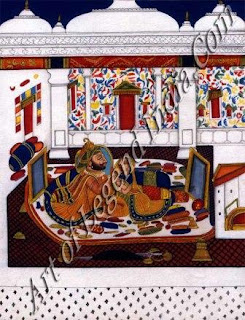 Dr
Raghuvir Singh observes that a new synthetic Indian culture emerged in the
reigns of the Great Mughals and these diverse influences had again begun to
mingle and flourish in the royal courts." In the period of Maharaja Anup
Singh this development attained its unique character.
Dr
Raghuvir Singh observes that a new synthetic Indian culture emerged in the
reigns of the Great Mughals and these diverse influences had again begun to
mingle and flourish in the royal courts." In the period of Maharaja Anup
Singh this development attained its unique character.
His
courtier Mussabir Ruknuddeen played a significant role in this process. He
executed hundreds of paintings such as those entitled Keshav's Rasikpriya and
Barahmasa. His whole family accepted fully the Bikaner style of painting. His
son Sahabudin executed many paintings on themes of the Bhagwad Puran and his
grandson Kayam painted in the Bikaner style at the beginning of the 18th
century.
In the
time of Anup Singh, Munna La11, Mukund, Chandu LaII and others belonging to the
Matheran family also made their special contribution to the development of the
Bikaner style. Artists from the Matheran and Usta families elevated the Bikaner
style to its climax of glory in the reign of Anup Singh, whose pictorial texts
and miniatures are preserved in the National Museum, the Baroda Museum and the
private collection of Maharaja Karni Singh.
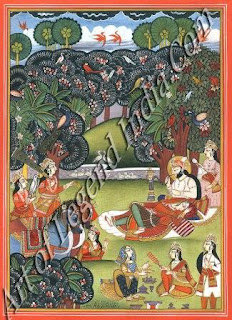 In the
18th century the Bikaner style witnessed its third phase. With the
steady downfall of the Mughals, the Bikaner style had freed itself from the
impact of the Mughal style, and because of matrimonial alliances the Bikaner
style was greatly influenced by the styles Of Jaipur, Bundi, Mewar and Pahari
besides others. The impact of the Kishangarh style upon paintings of this
period is quite discernible. In this period painters created an absolute
Rajasthani style.
In the
18th century the Bikaner style witnessed its third phase. With the
steady downfall of the Mughals, the Bikaner style had freed itself from the
impact of the Mughal style, and because of matrimonial alliances the Bikaner
style was greatly influenced by the styles Of Jaipur, Bundi, Mewar and Pahari
besides others. The impact of the Kishangarh style upon paintings of this
period is quite discernible. In this period painters created an absolute
Rajasthani style.
Artists
of the Matheran family however continued to maintain their traditions. They had
drafted copies of the Jain texts, and compiled such texts on festive occasions.
They drew personal pictures of kings to be presented to them. Many paintings
engraved with the names of artists like Munna Lall, Mukund (1668), Ram Kishan
(1770), Jai Kishan Matheran, Chandu Lall (1678) along with sanvants may be
viewed even today.''
Leading
artists of the Usta family of that period include Kayam, Kasim, Abu Harnid,
Shah Mohammad, Ahmad Al Sahabudin, Jivan who had brilliantly depicted
Rasikpriya, Barah-masa, Ragragini, Krishna Lila, hunting, mehafil and royal
splendour .
The
Bikaner style further accelerated the process of developing frescoes in the Rajasthani
tradition, palaces of Bikaner fort and many cenotaphs.
In
Bikaner, superb paintings were drawn on wooden boards showing Radha-Krishna as
in the wooden doors of the National Museum.'" Drawings on the hides of
camels are a unique feature of the Bikaner style.
Salient Features
 Because
of Bikaner state's close ties with the Mughal court all salient characteristics
of the Mughal style are quite visible in early paintings of the Bikaner style.
Many critics therefore term it a provincial Mughal style. But drawings of slim
and attractive females with eyes resembling those of deer, the frequent
application of blue, green and red colours, turbans of the style of Shahjahan
and Aurangzeb along with the high pagans of Marwari fashion, camels, deer and
the Bikaneri style of living and the impact of Rajput culture make us believe
it is a distinct style.
Because
of Bikaner state's close ties with the Mughal court all salient characteristics
of the Mughal style are quite visible in early paintings of the Bikaner style.
Many critics therefore term it a provincial Mughal style. But drawings of slim
and attractive females with eyes resembling those of deer, the frequent
application of blue, green and red colours, turbans of the style of Shahjahan
and Aurangzeb along with the high pagans of Marwari fashion, camels, deer and
the Bikaneri style of living and the impact of Rajput culture make us believe
it is a distinct style.
Rulers
of Bikaner often served as governors of the Mughals on the southern frontier
hence the impact of the southern style on Bikaner art is considerable. Tall and
slim maidens, minute drawings of cypress and coconut trees, fountains playing
and application of green colours are especially worth seeing. From the southern
fronts, Rajput soldiers and artists used to return via Vijayanagar, Golconda,
Ahmednagar, Malwa, hence the influence of the art of that region had its impact
on local art.
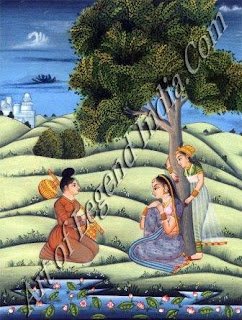 In the
Bikaner style, abrupt linings, delicate drawings and minute lines had
particularly been drawn. Arrangement of linings was very impressive. In place
of bright colours soft ones were applied. Application of red, violet, white,
brown and blue had frequently been made in this style. Ornaments of beads too
were frequently marked.
In the
Bikaner style, abrupt linings, delicate drawings and minute lines had
particularly been drawn. Arrangement of linings was very impressive. In place
of bright colours soft ones were applied. Application of red, violet, white,
brown and blue had frequently been made in this style. Ornaments of beads too
were frequently marked.
The
manner of dressing was a synthesis of Mughal and Rajput styles. As the
Kishangarh style women are drawn tall, with eyes resembling those of khanjan
birds and tight blouses and lambs, goats, camels, dogs and desert landscapes
drawn in the Bikaner style in the 18th century. In later styles, drawings of
fringed clouds are worth seeing in the frescoes of Chandra Mahal, Lall Niwas
and Sardar Mahal. Drawings of sand dunes influenced by Persian and Chinese art,
mountains and foliage deserve special mention.
The
Matheran and Usta families had developed the Bikaner style. Even today their
descendants produce paintings on auspicious occasions such as marriages. A last
ray of light of the Usta family, Hissamudin, had been internationally
ac-claimed for his drawings on the hides of camels.
Kishangarh Style
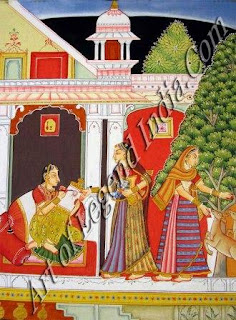 The
Kishangarh style of painting occupies a significant position in relation to Rajasthani
painting. A style of painting which flourished in the royal court of an
erstwhile tiny state located near Ajmer is famous. Credit for making it known
goes to Eric Dickinson and Dr Fayaz Ali.
The
Kishangarh style of painting occupies a significant position in relation to Rajasthani
painting. A style of painting which flourished in the royal court of an
erstwhile tiny state located near Ajmer is famous. Credit for making it known
goes to Eric Dickinson and Dr Fayaz Ali.
Kishangarh
state was founded by the eighth son of Raja Udai Singh of the Rathore dynasty
of Jodhpur state in 1609. Raja Kishan Singh was accorded the status of a
commander leading a thousand infantrymen and 500 cavalry by Em-peror Jehangir.
Closely connected with Jodhpur state and the Mughal court, the rulers of that
state were conversant with the royal culture and sophisticated way of living.
In the developed state of the Marwar school the Kishangarh style had acquired
its unique and glorious position in the realm of Rajasthani painting after
having ascended to the pinnacle of glory in the time of Savant Singh.
Raja
Roop Singh, fifth in lineage (1648-1658), made' Roop Nagar his capital to avoid
some strategic difficulties which had existed under the rule of Savant Singh.
Roop Singh was a man of outstanding intellect endowed with a kindly heart. Like
his forefathers, he had been initiated into the Vallabha sect and adopted the
cult of Krishna as a way of life and means of salvation. Contemporary artists
had started painting various modes of the Radha-Krishna tradition to convert
these myths into reality to keep their master pleased."
After
Roop Singh came Raja Man Singh (1658-1706), himself a distinguished poet as
well as patron of the poets and art. He was guided by the famous poet Brind in
the art of poetry. A devotee of the Vaishnav sect, he was keenly interested in
subjects pertaining to the Bhakti cult. He was also an artist in his own right.
Some paintings belonging to his time are preserved in the Kapad Bhandar of
Kishangarh."
In the
growth of painting in this region his son Raj Singh (1706-1748) also played a
major role. Raj Singh was an extraordinarily brave person endowed with a
strictly religious temperament as well as artistic bent of mind. He himself
compiled 33 texts which greatly influenced artists of that age. From this time
the king-designate, Raja Savant Singh, was much influenced by his father's
dedication to art. His education and religious initiation had been performed as
his father desired to live in an artistic environment. He was at home as much
in Sanskrit as in music. He also took a keen interest in painting. Four
paintings in the private collection of the Kishangarh royal family bear
testimony to this.
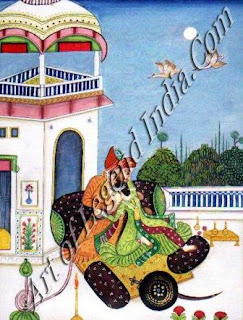 Savant
Singh had cultivated a great taste for poetry early in life. From 1723 to 1731
he contributed significantly to expanding the volume of poetry dedicated to
Krishna-Bhakti after compiling Manorath Man jar, Rasik Ratnavali, Bihari
Chan-drika. Like their forefathers they had been initiated in the Vallabha sect
by their spiritual master Ran Chhor Dass.
Savant
Singh had cultivated a great taste for poetry early in life. From 1723 to 1731
he contributed significantly to expanding the volume of poetry dedicated to
Krishna-Bhakti after compiling Manorath Man jar, Rasik Ratnavali, Bihari
Chan-drika. Like their forefathers they had been initiated in the Vallabha sect
by their spiritual master Ran Chhor Dass.
In the
style of painting created in the middle of the 18th century new trends are
visualised. The pleasant temperament of Radha-Krishna is depicted in the new
form. To provide fine shapes to this style, credit goes to the royal
courtier-aim-artist Mordhavaj Nihal Chand. Hundreds of paintings by him remain
as an invaluable heritage. The grandfather of Nihal Chand, Surdhavaj Moot Raj,
came from Delhi to serve as Raja Man Singh's diwan.
Later
artists of his generation contributed to the growth of the Kishangarh style.
Nihal Chand illustrated the brush poetry of Nagri Dass from 1735 to 1738. After
Nagri Dass's Vrindavanbass, drawings of Mussavir Ni hal Chand continued to
appear in the state, but in these later drawings his magic touch was missing.
The
painting of this age is often associated with the love life of Vanithani and
Nagri Dass, but this is not historically true. The former ruler of Kishangarh
denied this view and stated: "Vanithani was a state singer whose status in
the royal family resembled that of a mother for her sister. But it was a
different matter that Vanithani had herself been a singer and poetess.
Paintings of that time might have been influenced by her impact."
Ancestors
of Diwan Surdhavaj Moo! Raj significantly contributed to the growth of
Kishangarh art, Sita Ram and Badan Singh stand eminent among them. Drawings of
Amroo and Suraj Mal are ascribed to the period of Nagri Dass. The artist Nanak
Ram also created many paintings in the time of the brother of Nagri Dass.
Artistic workmanship performed by Ram Nath and Joshi Swami Ram, ancestors of
Nanak Ram, in the period of Raja Birad Singh (1782-1788) was greatly admired.
In the regime of Raja Kalyan Singh (1798-1838) an artist named Ladli Dass
played a very striking role in the development of the Kishangarh style. A
renowned painting titled Geet-Govind was also created in the same period.
By and
by the eternal quality of the Kishangarh style began to lose its distinct
character. Its deterioration began to be visible in paintings in the reign of
Prithvi Singh (1840-1880). After this period, the Kishangarh style was lost in
oblivion.
Salient Features
The
Kishangarh style possesses some distinct features which maintain its unique
identity. Drawings of limbs of males and females, colourful paintings of
nature, arrangement of colours, illustrations of themes connected with the
Radha-Krishna cult are some distinct features of this style.
 Male
figures are tall, of attractive physique with blue aura-like bunch as of hair,
elevated turbans, with strings of pearls in white or blue, symmetrically
developed forehead, thin lips and wide and attractive eyes stretched to the
ears like khanjan birds are some unique features of the Kishangarh style. On
the whole the eyes occupy such an important position that the viewer is first
drawn to that spot. Pointed chin, long neck resembling a surahi of water,
strong arms, round and tender fingers, transparent gowns draped down to the
feet, and the whole body covered with ornaments and flowers are very distinct
in the Kishangarh style.
Male
figures are tall, of attractive physique with blue aura-like bunch as of hair,
elevated turbans, with strings of pearls in white or blue, symmetrically
developed forehead, thin lips and wide and attractive eyes stretched to the
ears like khanjan birds are some unique features of the Kishangarh style. On
the whole the eyes occupy such an important position that the viewer is first
drawn to that spot. Pointed chin, long neck resembling a surahi of water,
strong arms, round and tender fingers, transparent gowns draped down to the
feet, and the whole body covered with ornaments and flowers are very distinct
in the Kishangarh style.
Female
figures are fair in complexion, and their wide eyes are adorned with kajal.
Semi-developed
but firm breasts, body covered with lehnga, odhni and kanchuki and decorated
with flowers and ornaments are salient features and half-blossomed buds of
lotus in the hands exhibit the charm and beauty of the nayika-like Radha.
The natural perspective of
Kishangarh and Roopangarh was endowed with lakes, mountains, gardens, various
birds, and accordingly drawings of nature showed frequently large lakes spread
far and wide, swans sporting in them, ducks, jahnugabi, cranes, bagula, heron
and boats afloat and at anchor. Krishna engaged in romantic affairs in boats.
Large buildings, white parapets covered with creepers, fountains and ponds
covered with flowering lotus together make the Kishangarh style charming.
Similar drawings were created in the Bundi style too, showing the love play of
Radha-Krishna in the full moonlight, drawings of morning and evening clouds in
crimson.
The
Kishangarh style has its own combination of colours. To express tender
sentiments of Radha-Krishna artists often used light colours. The principal
colours were white, rose, cream and deep red. Margins are drawn in rose and
green.
Writer – Jai Singh Neeraj
 Like
Mewar, Maru Pradesh followed the traditions of Ajanta. Its preliminary form may
be seen from the artistic shape of the gate of Mandore.' This region attained
fame in the domain of art and culture under the rule of the Gurjara-Pratiharas.
Like
Mewar, Maru Pradesh followed the traditions of Ajanta. Its preliminary form may
be seen from the artistic shape of the gate of Mandore.' This region attained
fame in the domain of art and culture under the rule of the Gurjara-Pratiharas.
 After
establishing his kingdom, Jodhaji contributed impressively to the prosperity
and enrichment of Indian culture in this new field. The Jain, Gujarat and
Apbhransh styles were revived in new form. Credit goes to Maldeo (1532-68) for
giving renewed vigour to the cultural traditions and artistic perspectives of
Marwar. Before him, the Marwar style maintained its complete mastery over the
Jodhpur style, but MaIdeo carved out an independent Marwar and devoted himself
to the growth of the arts. From the point of view of primitive art, the
Uttaradhyayan Sutra of his time, now preserved in Baroda Museum, occupies a
prominent place. Glimpses of paintings of that age may also be visualised in
the frescoes of Chaukhela Palace.
After
establishing his kingdom, Jodhaji contributed impressively to the prosperity
and enrichment of Indian culture in this new field. The Jain, Gujarat and
Apbhransh styles were revived in new form. Credit goes to Maldeo (1532-68) for
giving renewed vigour to the cultural traditions and artistic perspectives of
Marwar. Before him, the Marwar style maintained its complete mastery over the
Jodhpur style, but MaIdeo carved out an independent Marwar and devoted himself
to the growth of the arts. From the point of view of primitive art, the
Uttaradhyayan Sutra of his time, now preserved in Baroda Museum, occupies a
prominent place. Glimpses of paintings of that age may also be visualised in
the frescoes of Chaukhela Palace.  Rag-Main,
an illustrated text painted in 1623 and preserved in the private collection of
Sangram Singh, is a compilation of great historical value painted for the
famous Vitthal Dass of Pali. These paintings are considerably influenced by the
art of Marwar.
Rag-Main,
an illustrated text painted in 1623 and preserved in the private collection of
Sangram Singh, is a compilation of great historical value painted for the
famous Vitthal Dass of Pali. These paintings are considerably influenced by the
art of Marwar.  Because
of the great valour and courage of Durga Dass, the reign of Ajit Singh was a
landmark in the annals of the development of Rajasthani art. Paintings of that
age had themes like Rasikpriya, Geet-Govind, poetical texts and aspects of the
royal court, hunting, festivals, processions, pictures of kings and feudal
lords. Royal patronage in the reigns of Abhaya Singh and Rain Singh to artists
in the Jodhpur style was generous. In the 19th century, the Nath
sect dominated the life of Marwar.
Because
of the great valour and courage of Durga Dass, the reign of Ajit Singh was a
landmark in the annals of the development of Rajasthani art. Paintings of that
age had themes like Rasikpriya, Geet-Govind, poetical texts and aspects of the
royal court, hunting, festivals, processions, pictures of kings and feudal
lords. Royal patronage in the reigns of Abhaya Singh and Rain Singh to artists
in the Jodhpur style was generous. In the 19th century, the Nath
sect dominated the life of Marwar.  The
Jodhpur style is the principal style of the Marwar school, but even today a
large number of paintings in this style are not available, and whatever is
available belongs to the early part of the 19th century. Despite
being influenced by the Mewar school, the Jodhpur style has its own striking
features, and as a result its separate constitution comes to light.
The
Jodhpur style is the principal style of the Marwar school, but even today a
large number of paintings in this style are not available, and whatever is
available belongs to the early part of the 19th century. Despite
being influenced by the Mewar school, the Jodhpur style has its own striking
features, and as a result its separate constitution comes to light.  In
distant Maru Pradesh, the state of Bikaner was founded by Rao Bikaji of the
Rathore dynasty in 1488. Being an integral part of Marwar and belonging to the
same dynasty of Jodhpur, the artistic heritage of Bikaner is recognised as a
signifi-cant link in the traditions of the Marwar school. Although influenced
by many external forces, Bikaner maintains its original form intact. According
to the artistic and other styles of Rajasthan, painting in Bikaner commenced
its development from the end of the 16th century.
In
distant Maru Pradesh, the state of Bikaner was founded by Rao Bikaji of the
Rathore dynasty in 1488. Being an integral part of Marwar and belonging to the
same dynasty of Jodhpur, the artistic heritage of Bikaner is recognised as a
signifi-cant link in the traditions of the Marwar school. Although influenced
by many external forces, Bikaner maintains its original form intact. According
to the artistic and other styles of Rajasthan, painting in Bikaner commenced
its development from the end of the 16th century.  Kalyan
Mal, Raja of Bikaner, established relations with the Mughals after marrying his
daughter to Emperor Akbar. The rulers of Bikaner occupied prominent positions
in Mughal courts." Maharana Rai Singh, who held the exalted position of
governor of Burhanpur in the south from 1604 to 1611, made a good collection of
artifacts. In this regard the illustrated texts of Rag-Mala are very
significant.
Kalyan
Mal, Raja of Bikaner, established relations with the Mughals after marrying his
daughter to Emperor Akbar. The rulers of Bikaner occupied prominent positions
in Mughal courts." Maharana Rai Singh, who held the exalted position of
governor of Burhanpur in the south from 1604 to 1611, made a good collection of
artifacts. In this regard the illustrated texts of Rag-Mala are very
significant.  In the
reign of Shahjahan the number of artists greatly increased and many migrated to
other places to receive royal patronage. Because of the indifferent attitude of
Emperor Aurangzeb to artistic activities, artists sought patronage in the
princely states of Rajasthan. The renowned Usta family of Bikaner, which was
concentrated in Lahore in the Mughal period, joined the courts of Maharajas
Karni Singh and Anup Singh at Bikaner in the reign of Aurangzeb. In paintings
in the Bikaner style, the name of the artist along with that of his father and
sanvant are engraved. Usta Asir Khan came to Bikaner from Delhi in the time of
Karni Singh (1650) and developed a high sense of artistry.
In the
reign of Shahjahan the number of artists greatly increased and many migrated to
other places to receive royal patronage. Because of the indifferent attitude of
Emperor Aurangzeb to artistic activities, artists sought patronage in the
princely states of Rajasthan. The renowned Usta family of Bikaner, which was
concentrated in Lahore in the Mughal period, joined the courts of Maharajas
Karni Singh and Anup Singh at Bikaner in the reign of Aurangzeb. In paintings
in the Bikaner style, the name of the artist along with that of his father and
sanvant are engraved. Usta Asir Khan came to Bikaner from Delhi in the time of
Karni Singh (1650) and developed a high sense of artistry.  Dr
Raghuvir Singh observes that a new synthetic Indian culture emerged in the
reigns of the Great Mughals and these diverse influences had again begun to
mingle and flourish in the royal courts." In the period of Maharaja Anup
Singh this development attained its unique character.
Dr
Raghuvir Singh observes that a new synthetic Indian culture emerged in the
reigns of the Great Mughals and these diverse influences had again begun to
mingle and flourish in the royal courts." In the period of Maharaja Anup
Singh this development attained its unique character. In the
18th century the Bikaner style witnessed its third phase. With the
steady downfall of the Mughals, the Bikaner style had freed itself from the
impact of the Mughal style, and because of matrimonial alliances the Bikaner
style was greatly influenced by the styles Of Jaipur, Bundi, Mewar and Pahari
besides others. The impact of the Kishangarh style upon paintings of this
period is quite discernible. In this period painters created an absolute
Rajasthani style.
In the
18th century the Bikaner style witnessed its third phase. With the
steady downfall of the Mughals, the Bikaner style had freed itself from the
impact of the Mughal style, and because of matrimonial alliances the Bikaner
style was greatly influenced by the styles Of Jaipur, Bundi, Mewar and Pahari
besides others. The impact of the Kishangarh style upon paintings of this
period is quite discernible. In this period painters created an absolute
Rajasthani style.  Because
of Bikaner state's close ties with the Mughal court all salient characteristics
of the Mughal style are quite visible in early paintings of the Bikaner style.
Many critics therefore term it a provincial Mughal style. But drawings of slim
and attractive females with eyes resembling those of deer, the frequent
application of blue, green and red colours, turbans of the style of Shahjahan
and Aurangzeb along with the high pagans of Marwari fashion, camels, deer and
the Bikaneri style of living and the impact of Rajput culture make us believe
it is a distinct style.
Because
of Bikaner state's close ties with the Mughal court all salient characteristics
of the Mughal style are quite visible in early paintings of the Bikaner style.
Many critics therefore term it a provincial Mughal style. But drawings of slim
and attractive females with eyes resembling those of deer, the frequent
application of blue, green and red colours, turbans of the style of Shahjahan
and Aurangzeb along with the high pagans of Marwari fashion, camels, deer and
the Bikaneri style of living and the impact of Rajput culture make us believe
it is a distinct style.  In the
Bikaner style, abrupt linings, delicate drawings and minute lines had
particularly been drawn. Arrangement of linings was very impressive. In place
of bright colours soft ones were applied. Application of red, violet, white,
brown and blue had frequently been made in this style. Ornaments of beads too
were frequently marked.
In the
Bikaner style, abrupt linings, delicate drawings and minute lines had
particularly been drawn. Arrangement of linings was very impressive. In place
of bright colours soft ones were applied. Application of red, violet, white,
brown and blue had frequently been made in this style. Ornaments of beads too
were frequently marked.  The
Kishangarh style of painting occupies a significant position in relation to Rajasthani
painting. A style of painting which flourished in the royal court of an
erstwhile tiny state located near Ajmer is famous. Credit for making it known
goes to Eric Dickinson and Dr Fayaz Ali.
The
Kishangarh style of painting occupies a significant position in relation to Rajasthani
painting. A style of painting which flourished in the royal court of an
erstwhile tiny state located near Ajmer is famous. Credit for making it known
goes to Eric Dickinson and Dr Fayaz Ali. Savant
Singh had cultivated a great taste for poetry early in life. From 1723 to 1731
he contributed significantly to expanding the volume of poetry dedicated to
Krishna-Bhakti after compiling Manorath Man jar, Rasik Ratnavali, Bihari
Chan-drika. Like their forefathers they had been initiated in the Vallabha sect
by their spiritual master Ran Chhor Dass.
Savant
Singh had cultivated a great taste for poetry early in life. From 1723 to 1731
he contributed significantly to expanding the volume of poetry dedicated to
Krishna-Bhakti after compiling Manorath Man jar, Rasik Ratnavali, Bihari
Chan-drika. Like their forefathers they had been initiated in the Vallabha sect
by their spiritual master Ran Chhor Dass.  Male
figures are tall, of attractive physique with blue aura-like bunch as of hair,
elevated turbans, with strings of pearls in white or blue, symmetrically
developed forehead, thin lips and wide and attractive eyes stretched to the
ears like khanjan birds are some unique features of the Kishangarh style. On
the whole the eyes occupy such an important position that the viewer is first
drawn to that spot. Pointed chin, long neck resembling a surahi of water,
strong arms, round and tender fingers, transparent gowns draped down to the
feet, and the whole body covered with ornaments and flowers are very distinct
in the Kishangarh style.
Male
figures are tall, of attractive physique with blue aura-like bunch as of hair,
elevated turbans, with strings of pearls in white or blue, symmetrically
developed forehead, thin lips and wide and attractive eyes stretched to the
ears like khanjan birds are some unique features of the Kishangarh style. On
the whole the eyes occupy such an important position that the viewer is first
drawn to that spot. Pointed chin, long neck resembling a surahi of water,
strong arms, round and tender fingers, transparent gowns draped down to the
feet, and the whole body covered with ornaments and flowers are very distinct
in the Kishangarh style. 










Its Great and Famous Indian Art
Visit W3Schools.com!